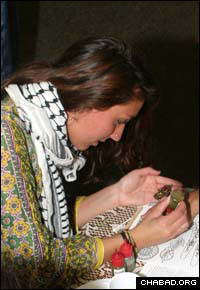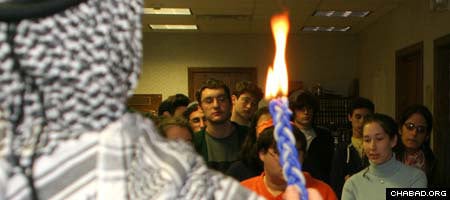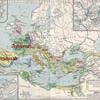Students at Binghamton University sampled from a smorgasbord of Jewish culture last month during an exploration of the Jewish people's two primary traditions – those with roots in Eastern Europe and those whose families lived in Spain before the 15th-century Inquisition.
The "Ashkafardic Night," as the sponsoring Chabad House Jewish Student Center billed the Nov. 17 event, brought together some 100 collegians for a show-and-tell of sorts of their heritage. The evening, held in a makeshift Middle Eastern tent perched in the middle of a room and surrounded by paper flags and informational exhibits, showcased traditions and foods all the way from the ancient Jewish community of Morocco to the Russian shtetl to modern-day Israel.
The term Ashkenazic refers to the community of Jews descended from Central and Eastern European lands, who until the modern day largely spoke Yiddish. Sephardic, on the other hand, refers to the community of Jews descended from the Iberian Peninsula who after the Inquisition spread out to North Africa, the Netherlands, Italy, the Caribbean and Mexico. In addition to their divergent cultural traditions, each of which spawned many subgroups over the years, the two meta-groups developed some different customs in relation to the application of Jewish law.
Jewish communities rooted in the Middle East, some going back as far as the 6th-century BCE expulsion of Jews from the Land of Israel by the Babylonians, were also represented.
"There's so much diversity within Jewish culture itself, in that you have Ashkenazic culture and Sephardic culture," explained Bernie Sonnenberg, 21, a senior at Binghamton and vice president of the Chabad House's student executive board. "The idea of this event was to simultaneously celebrate these two cultures as well as to expose people to them."
In typical Jewish communal settings, such as synagogues, Ashkenazic and Sephardic Jews rarely mix given their prayer books' different rites and their family's different customs. At the Binghamton Chabad House, however, as at other Chabad Houses across the United States, both groups coexist; Chabad-Lubavitch rabbis encourage members of each group to hold on to their cultural identities.
Sonnenberg said that the presence of the Chabad House – which since 1985 has served the religious, educational, social and pastoral needs of the thousands of Jewish students at Binghamton – was a factor in his decision to go the university. Others, however, discovered in the center a chance to explore their Jewish heritage in ways they weren't able to as children.
"Before I came to Binghamton, I came from an Ashkenazic neighborhood," said Danielle Skurnick, 21, another senior at the school and the Chabad House's social chair. "And here there are so many different groups of Jewish people."
Skurnick spearheaded and organized the Saturday night event, which began with a traditional Havdallah service marking the end of Shabbat.
"I just loved seeing it all coming together," she offered.
From Music to Food

In addition to mouth-watering tables of food, the room sprang alive with elaborate light decorations and displays representing approximately 15 countries, said Skurnick. Some students wore ethnic clothing, such as the handful who came dressed in traditional Moroccan djellaba.
In an interesting twist, Elana Mallov, a student of Ashkenazic ancestry, demonstrated her artistry as she applied henna designs – an artwork from North Africa using a body paint derived from a flower – onto women's arms. According to the 21-year-old sophomore, the all-natural semi-permanent dye is used by some groups during a wedding celebration.
"It's beautiful for a short period of time," said Mallov, who carefully weaved the reddish-brown substance into intricate patterns on her subjects' hands and wrists. "They'll put a blob of henna on the bride's hand, who will then stamp it on everyone else's hands."
Meanwhile, music resonated through the room. At one point, the mixture of Ashkenazic songs and Israeli rhythms inspired a dance-off between a Syrian-Jewish student and another of Eastern European ancestry. For the trivia-inclined students, Sonnenberg hosted a game about famous Ashkenazic Jews, covering figures such as Jonas Salk and Albert Einstein.
But what stuck out for Skurnick was the Havdallah service conducted by Rabbi Aaron Slonim, who combined different melodies into the service's prayers.
"It worked so well," said Skurnick. "It sparked a lot of attention, and a lot of people really appreciated it. Immediately, both the Ashkenazic and the Sephardic groups were brought together."
Slonim and his wife, fellow co-director Rivkah Slonim, helped organize the evening, which has become something of a tradition at Binghamton and is held every three or four years.
"They set the model," Skurnick said in thanking the Slonims, whom she credited with giving the Jewish student community the guidance and support needed to thrive. "They gave us some ideas of what's been done in the past."
Said Sonnenberg: "When you stepped into the Chabad house, you really felt like you were entering a land of many cultures."









Start a Discussion